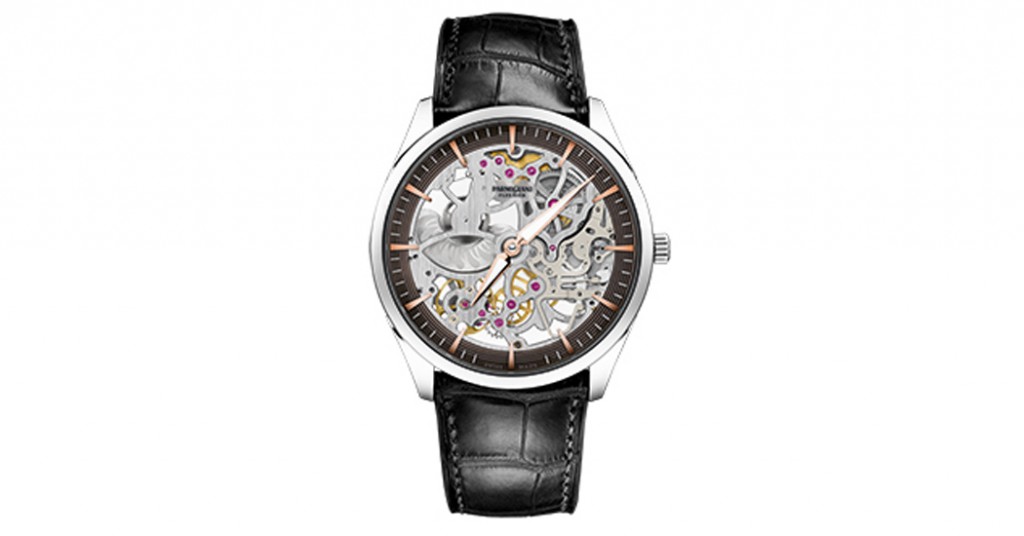Parmigiani Fleurier is paying tribute to its iconic ultra-thin model – the Tonda 1950 – honoring it with a fully skeletonized dial to showcase the minute details of its mechanism. Successfully skeletonizing an ultra-thin movement, whose slim structure renders it fragile, requires master craftsmanship and the ability to translate the skill inherent in the caliber’s design. This process reveals all the refinement of the movement, from the complexity of its drivetrain to the beauty of each decoration. It is these details that make the Tonda 1950 Skeleton so prestigious.
The new caliber PF707 has been laid bare. The Tonda 1950 Skeleton exposes its gears, including components which never usually see the light of day. The main plate and bridges have been skeletonized to their very limits, only retaining as much substance as the watch needs to operate. This skeletonizing process demands that a perfect balance be struck between laying the movement bare, to better unveil its mysteries, and retaining the rigidity of each component – essential in ensuring it works as designed.
The barrel is also open, finally allowing the winding spring – the source of energy for the watch – to be seen with the naked eye underscoring the master craftsmanship. The oscillating micro-weight can now be glimpsed from the back and on the surface of the movement. Its intricate decoration is worthy of such scrutiny, with engraved “barley grain” on the back of the rotor and a pattern composed of Parmigiani Fleurier’s iconic lugs, key to the brand’s design DNA, on its surface.
The lug pattern is laid out so as to evoke a rotating movement, accentuating the circumvolutions of this oscillating weight. The caliber PF707 has 18 internal angles on the bridges and main plate, and every detail is carefully chosen to enhance the skeleton work.
The Tonda 1950 Skeleton has a sapphire dial, ensuring nothing obstructs the view of the skeletonized movement, except around the periphery, where the crystal is enclosed by a rose gold metal flange displaying the minute track and indices. The back of this flange features minutely detailed engraving, with fine, elegant concentric snailing adorning its surface. The dial highlights the composition of the Tonda 1950 Skeleton, set on many levels. The flange sits atop the skeletonized movement, which cascades below it on the many levels required by its complex kinematics. The entire piece has an enthralling 3D effect which reflects light and draws in the gaze.
The Tonda 1950 Skeleton boasts the timeless elegance of an ultra-thin model with careful attention paid to each area of volume, ensuring it is harmonious, ergonomic and based on the golden ratio. The steel case is 40 mm in diameter, with a thickness of just 8.2 mm. It extends into four lugs which flank the strap, with their iconic teardrop shape beautifully echoing the curve of the wrist. The steel folding buckle can be adjusted to 5 positions. With one press, the wearer can adjust the effective length of the strap, millimeter by millimeter, without having to switch to another attachment hole in the leather. Everything has been carefully designed to ensure the wearer enjoys perfect comfort and ergonomics.
The Parmigiani Fleurier watchmaking center has devoted all of its cutting-edge expertise to perfecting the precision of the PF707 movement. This is the case for the variable-inertia balance, which now eliminates the need for the conventional index-assembly. This innovation makes it possible to adjust the moment of inertia by rotating the inertia blocks rather than adjusting the active length of the balance-spring as required with a standard adjustment.
The movement is more stable over the long term, more shock-resistant, with outstanding isochronism guaranteed. The skeletonization of the PF707 movement allows its mysteries to be unveiled without making it more fragile, thanks to the skill of its design, and the expertise of the brand’s independent watchmaking center.








